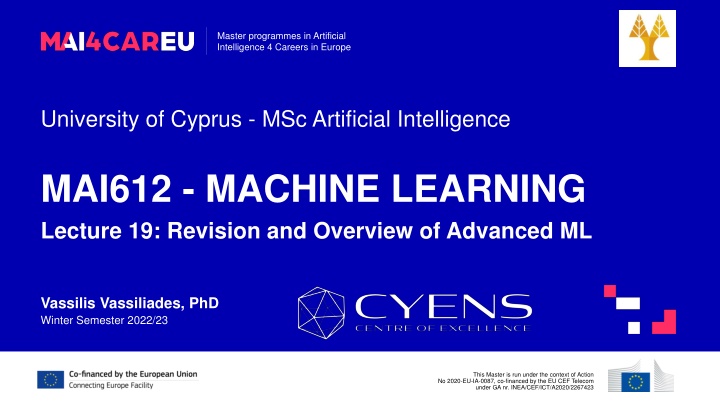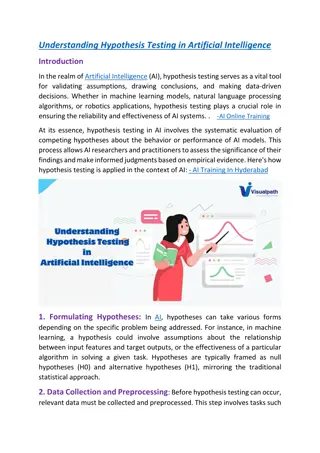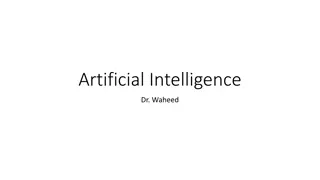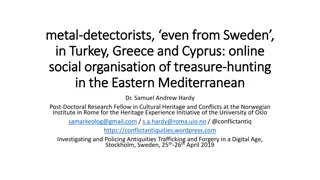Master's Program in Artificial Intelligence at University of Cyprus - Winter Semester 2022/23
A Master's program in Artificial Intelligence at the University of Cyprus for careers in Europe, focusing on Machine Learning. The program, led by Dr. Vassilis Vassiliades, offers a range of advanced ML topics in the Winter Semester 2022/23.
Download Presentation

Please find below an Image/Link to download the presentation.
The content on the website is provided AS IS for your information and personal use only. It may not be sold, licensed, or shared on other websites without obtaining consent from the author.If you encounter any issues during the download, it is possible that the publisher has removed the file from their server.
You are allowed to download the files provided on this website for personal or commercial use, subject to the condition that they are used lawfully. All files are the property of their respective owners.
The content on the website is provided AS IS for your information and personal use only. It may not be sold, licensed, or shared on other websites without obtaining consent from the author.
E N D
Presentation Transcript
Master programmes in Artificial Intelligence 4 Careers in Europe University of Cyprus - MSc Artificial Intelligence MAI612 - MACHINE LEARNING Lecture 19: Revision and Overview of Advanced ML Vassilis Vassiliades, PhD Winter Semester 2022/23 This Master is run under the context of Action No 2020-EU-IA-0087, co-financed by the EU CEF Telecom under GA nr. INEA/CEF/ICT/A2020/2267423
Master programmes in Artificial Intelligence 4 Careers in Europe Revision This Master is run under the context of Action No 2020-EU-IA-0087, co-financed by the EU CEF Telecom under GA nr. INEA/CEF/ICT/A2020/2267423
Master programmes in Artificial Intelligence 4 Careers in Europe Introduction to ML ML is a subfield of AI that uses data to teach computers how to predict and act Can be seen as program discovery from data Its goal is to generalize to unseen data, rather than memorizing ML has countless applications: Spam filter Grouping customers to drive marketing actions Predicting whether a tumor is benign or malignant from (from features such as its size) Predicting house prices (from features such as size and number of bedrooms) Animal sound recognition Image recognition (e.g., faces, products, characters, medical images) Natural language translation Recommender systems (e.g., movies, music, news) Identifying whether an industrial machine is faulting from its noise levels Teaching a robot dog to walk This Master is run under the context of Action No 2020-EU-IA-0087, co-financed by the EU CEF Telecom under GA nr. INEA/CEF/ICT/A2020/2267423 3
Master programmes in Artificial Intelligence 4 Careers in Europe Introduction to ML There are 3 main types of ML approaches: Supervised learning: when we have labels Classification Regression Unsupervised learning: when we do not have labels Clustering Dimensionality Reduction Anomaly Detection Matrix completion (e.g. recommender systems) Reinforcement learning: when the problem involves sequential decision making The ML project lifecycle: Strategy -> Data Preparation <-> Model Development <-> Model Deployment This Master is run under the context of Action No 2020-EU-IA-0087, co-financed by the EU CEF Telecom under GA nr. INEA/CEF/ICT/A2020/2267423 4
Master programmes in Artificial Intelligence 4 Careers in Europe Data Preparation Types of data: Tabular, Text, Images, Signals (audio), Video, Point clouds, Graphs Data Collection: acquiring, integrating, labelling Need to have diversity Data Preprocessing: Data cleaning: fix inconsistencies, missing data, remove duplicates Data encoding: one-hot encoding, ordinal encoding Data Visualization: see patterns, problems Can use dimensionality reduction This Master is run under the context of Action No 2020-EU-IA-0087, co-financed by the EU CEF Telecom under GA nr. INEA/CEF/ICT/A2020/2267423 5
Master programmes in Artificial Intelligence 4 Careers in Europe Data Preparation Data Transformation: Feature scaling: min-max normalization: when we know the feature ranges Mean-normalization: when we don t know the feature ranges Feature selection: choose a subset of the features L1-regularization can sometimes perform feature selection Feature Extraction: features with lower dimensionality than the original PCA, Autoencoders Feature Engineering: additional features Polynomial features, domain knowledge Data Augmentation: additional data points (when we have small or imbalanced dataset) Data Sampling: remove points (when we have a huge or imbalanced dataset) Dataset splitting: training, validation (or cross-validation), test sets This Master is run under the context of Action No 2020-EU-IA-0087, co-financed by the EU CEF Telecom under GA nr. INEA/CEF/ICT/A2020/2267423 6
Master programmes in Artificial Intelligence 4 Careers in Europe Regression Regression is the supervised learning problem of predicting a continuous value K-nearest neighbor regression Nonparametric model Prediction is the average of the K nearest neighbors K=1: noisy, 1<K<m better captures the trend, K=m always produces the average of all Strengths: no training time, handles nonlinearities, Weaknesses: prediction becomes slower as the dataset becomes larger, Linear regression Parametric model: 1 parameter per feature + intercept term Prediction is the dot product of parameter vector and input vector (weighted sum) Learning can be done either using gradient-based methods (iterative) or computing the analytic solution (non-iterative) This Master is run under the context of Action No 2020-EU-IA-0087, co-financed by the EU CEF Telecom under GA nr. INEA/CEF/ICT/A2020/2267423 7
Master programmes in Artificial Intelligence 4 Careers in Europe Regression Linear regression optimizes the MSE, which has a convex shape (single optimum) Gradient descent starts from a random point (parameter vector), and alternates by computing the partial derivatives of a function at that point and modifying the point by adding a value proportional to the negative gradient A small learning rate results in slower convergence, a large learning rate may result in divergence Need to use feature scaling with gradient descent The analytic solution is not iterative (does not start from a random initial parameter vector) Fast for small number of features and points Cannot use it for very large number of features (e.g., thousands) and points (e.g., thousands or millions) Does not use regularization (could overfit when using a large number of features) Linear regression Strengths: constant prediction time, analytic solution easy to implement, Weaknesses: cannot model nonlinear relationships, Weakness can be addressed using polynomial features This Master is run under the context of Action No 2020-EU-IA-0087, co-financed by the EU CEF Telecom under GA nr. INEA/CEF/ICT/A2020/2267423 8
Master programmes in Artificial Intelligence 4 Careers in Europe Classification Classification is the supervised learning problem of predicting a discrete value K-nearest neighbor classification Prediction is the majority vote of the K nearest neighbors K=1: fit the noise, K=m always predict the majority class Logistic regression Simple method for binary classification Feeds the output of linear regression through the sigmoid function which makes it in [0,1] The output is seen as the estimated probability of predicting the positive class Uses a default (probability) threshold of 0.5 for placing the decision boundary Decision boundary of logistic regression is linear, can be nonlinear if we use polynomial features Logistic regression optimizes the Cross-Entropy error which has a convex shape We use gradient-based methods to find the minimum The CE error penalizes the model a lot if its predicted probability is very far from the actual This Master is run under the context of Action No 2020-EU-IA-0087, co-financed by the EU CEF Telecom under GA nr. INEA/CEF/ICT/A2020/2267423 9
Master programmes in Artificial Intelligence 4 Careers in Europe Classification Error analysis for binary classifiers True positives, True Negatives, False Positives and False Negatives Metrics: Accuracy, Precision, TP rate, FP rate, F1-score ROC curve: plots the FP rate and the TP rate for all classification thresholds AUC score: a single metric based on ROC which can be used to compare classifiers Multiclass classification One-vs-rest: train K binary classifiers; prediction is the class of the most confident classifier Softmax: uses one-hot encoding of classes; prediction is a probability distribution over K classes Confusion matrix for multiclass classification TPs: diagonal TP rate (class A): TP(class A) / number of samples for class A Precision: TP(class A) / number of predictions for class A Accuracy: number of TPs / total number of samples This Master is run under the context of Action No 2020-EU-IA-0087, co-financed by the EU CEF Telecom under GA nr. INEA/CEF/ICT/A2020/2267423 10
Master programmes in Artificial Intelligence 4 Careers in Europe Model Evaluation and Improvement We want our models to exhibit generalization capabilities instead of memorizing the training set. Generalization: good performance on unseen data, drawn from the same distribution Underfitting: too simple model / high bias Overfitting: too complex model / fit the noise rather than the trend / high variance The bias-variance tradeoff is the conflict of trying to minimize both bias and variance Practically, we achieve that by splitting the dataset into a training, validation and test sets, and selecting the model that has the lowest validation error. k-fold cross validation: splits the training+validation dataset into k subsets, and trains k independent models where subset ? is used for validation and the remaining as training set the performance of the model is the average validation error over all k subsets used when the dataset is small, because of its complexity in training k models rather than just one. This Master is run under the context of Action No 2020-EU-IA-0087, co-financed by the EU CEF Telecom under GA nr. INEA/CEF/ICT/A2020/2267423 11
Master programmes in Artificial Intelligence 4 Careers in Europe Model Evaluation and Improvement Learning curves can be used to inspect whether we need to acquire more data More data typically benefits high variance models but not high bias ones Regularization is a penalty given to the loss function of high variance models to reduce the magnitude of their parameters, and thus, their complexity L1 regularization uses the absolute value norm and can sometimes be used for feature selection L2 regularization users the Euclidean norm and typically produces a better fit than L1 Hyperparameter tuning is the process of varying the hyperparameters of models and learning algorithms, and select the combination that results in the lowest validation error. Model improvement can be achieved using ensembles: training multiple models instead of one and aggregating their outputs Improve high bias models through: complexification, ensembles Improve high variance models through: hyperparameter tuning, regularization, ensembles, more data This Master is run under the context of Action No 2020-EU-IA-0087, co-financed by the EU CEF Telecom under GA nr. INEA/CEF/ICT/A2020/2267423 12
Master programmes in Artificial Intelligence 4 Careers in Europe Trees and Forests Decision trees are models that have a natural if-then-else structure, thus being interpretable and fast For a given dataset, there can be multiple decision trees that classify the data An algorithm for learning decision trees needs to choose one that generalizes well by deciding the feature to use for splitting at each node, and when to stop splitting Using irrelevant features creates larger decision trees, thus simplicity is preferred The best feature to use for splitting is the one that is most informative, i.e., the one that minimizes the disorder aka entropy The entropy ? takes as input the proportion of positive examples ?+, and as ?+goes from 0 to 0.5, ? increases from 0 to 1, and as ?+goes from 0.5 to 1, ? decreases from 1 to 0. Information gain measures the expected reduction in entropy due to splitting on some feature A It is measured as the difference between the entropy of the initial set, and the weighted sum of the entropies in the branches We want to maximize information gain, or equivalently minimize the weighted sum To split on a continuous variable, we first calculate all possible unique thresholds (using the midpoints of pairs of sorted points), and select the one with the highest information gain. This Master is run under the context of Action No 2020-EU-IA-0087, co-financed by the EU CEF Telecom under GA nr. INEA/CEF/ICT/A2020/2267423 13
Master programmes in Artificial Intelligence 4 Careers in Europe Trees and Forests Regression trees: predict the average of the values in their leaf nodes use the variance instead of the entropy, and the variance reduction instead of the information gain Ensemble methods: typically have lower generalization error than single learners can reduce both bias and variance they rely on diverse learners that produce different errors aggregation function: average for regression, majority vote for classification Bagging trains models in parallel by varying their training data using sampling with replacement Random forests use bagging with the additional step of randomizing the feature choice Boosting trains models incrementally by focusing on previously misclassified examples Stacking is a method that trains models typically at 2 levels, where the predictions of the models at level 1 become training data for a model at level 2 which learns how to combine them. This Master is run under the context of Action No 2020-EU-IA-0087, co-financed by the EU CEF Telecom under GA nr. INEA/CEF/ICT/A2020/2267423 14
Master programmes in Artificial Intelligence 4 Careers in Europe Kernel methods Classification problems often require nonlinear decision boundaries These can be constructed using feature engineering, e.g., adding polynomial features As we add features, we increase the dimensionality of the input which often makes the problem linearly separable, i.e., easier to solve in higher dimensions However, this approach can exponentially increase the number of parameters to be learned, and has the disadvantage of needing to compute features explicitly Kernel trick: the technique of using kernel functions (i.e., similarity functions over pairs of raw data points) that allow the model to operate in a high-dimensional space without explicitly transforming the raw data in the higher dimensional space. Kernel examples: polynomial, Gaussian We can make valid kernels by combining valid kernels through addition, multiplication and scaling with a positive constant Kernel methods are instance-based learners which compute the similarity of an input with stored training points and multiply this by some learned weight which is specific for that particular training point This Master is run under the context of Action No 2020-EU-IA-0087, co-financed by the EU CEF Telecom under GA nr. INEA/CEF/ICT/A2020/2267423 15
Master programmes in Artificial Intelligence 4 Careers in Europe Kernel methods Support Vector Machines are binary classification models that learn the separating hyperplane with the maximum margin, and use kernels to deal with nonlinearly separable problems Maximum margin decision boundary: minimizes the generalization error, as it ensures that points are classified far from the separating hyperplane computed by finding the support vectors, i.e., the training points closest to the separating hyperplane Trained SVMs only need to keep the support vectors to make a prediction, which makes the prediction fast We can do multi-class classification with SVMs using the one-vs-rest approach Support Vector Regression extends SVMs to regression problems fits a line to the data with a margin (tube) around it ignores points inside the tube because their combined error is small This Master is run under the context of Action No 2020-EU-IA-0087, co-financed by the EU CEF Telecom under GA nr. INEA/CEF/ICT/A2020/2267423 16
Master programmes in Artificial Intelligence 4 Careers in Europe Kernel methods Radial-basis function (RBF) networks are kernel methods that compute nonlinear features of the input based on proximity to fixed centres. The output is a linear combination of coefficients and features Mainly used for regression, in particular for exact interpolation and approximation The centre of the kernel can be at a training point (exact interpolation), however, it can be elsewhere Commonly used kernel: Gaussian Value of 0 if distance between queried point and kernel centre is large Value of 1 if distance between queried point and kernel centre is 0 (same point) If (Gaussian width) is large: smoother fit, thus, higher bias, lower variance We can use the normal equations to compute the RBF network weights for interpolation and approximation (fixed centres) This Master is run under the context of Action No 2020-EU-IA-0087, co-financed by the EU CEF Telecom under GA nr. INEA/CEF/ICT/A2020/2267423 17
Master programmes in Artificial Intelligence 4 Careers in Europe Kernel methods We can adapt the weights, centre coordinates and Gaussian widths of an RBF network using gradient descent: results in better fit Unnormalized RBFs: more localized, need more (or wider) to cover the input space Normalized RBF networks may exhibit better generalization with fewer nodes RBF networks can be used for classification by feeding the output of regression RBF network into a sigmoid function (similarly to logistic regression) Gaussian processes: nonparametric probabilistic regression models that output not only the prediction but also the confidence in the prediction Probability distribution over functions: can sample functions from it Good for low-data problems Can be provided with prior knowledge about the function we want to model This Master is run under the context of Action No 2020-EU-IA-0087, co-financed by the EU CEF Telecom under GA nr. INEA/CEF/ICT/A2020/2267423 18
Master programmes in Artificial Intelligence 4 Careers in Europe Kernel methods Applications of SVMs: Cancer prediction from features Whether a mushroom is poisonous or not Spam filter (with low-dimensional features) Predict whether the income of a person exceeds 50K Applications of RBFs: Predict price of houses based on size + number of bedrooms Predict price of stocks based on time series data Predict the value of a continuous function based on sampled points Predict medical insurance costs based on age, gender, BMI, smoker, Predict wine quality (1-10) based on chemical characteristics This Master is run under the context of Action No 2020-EU-IA-0087, co-financed by the EU CEF Telecom under GA nr. INEA/CEF/ICT/A2020/2267423 19
Master programmes in Artificial Intelligence 4 Careers in Europe Neural Networks Artificial neurons compute the weighted sum of their inputs and feed it through an activation function which then becomes their output Activation functions: Heaviside step (non-differentiable) Perceptron model Linear Linear regression Sigmoid Logistic regression Perceptrons are linear classifiers By combining multiple perceptrons in layers we can classify nonlinearly separable problems E.g., XOR can be solved using 2 hidden neurons and 1 output neuron However, we cannot train them using gradient descent when they use the Heaviside step function as it is non-differentiable This Master is run under the context of Action No 2020-EU-IA-0087, co-financed by the EU CEF Telecom under GA nr. INEA/CEF/ICT/A2020/2267423 20
Master programmes in Artificial Intelligence 4 Careers in Europe Neural Networks Multilayer Perceptrons is a synonym for feedforward ANNs (typically with differentiable activation functions) As a classifier, an MLP with: 1 hidden layer forms open or convex decision regions 2 hidden layers create arbitrary decision regions Forward propagation is the process that feeds a data instance to the input layer of a NN and this is gradually transformed into the output prediction (regression or classification) through some nonlinear transformation. This nonlinear transformation computes features of the input which are learned A second hidden layer computes features as functions of existing features Learning in NNs can be done using backpropagation and gradient descent This Master is run under the context of Action No 2020-EU-IA-0087, co-financed by the EU CEF Telecom under GA nr. INEA/CEF/ICT/A2020/2267423 21
Master programmes in Artificial Intelligence 4 Careers in Europe Neural Networks Backpropagation: an efficient way to compute partial derivatives of the error function with respect to each parameter using the chain rule (since a NN is a composition of functions) Error function: MSE for regression, Cross-Entropy for classification Forward propagation computes the activation (output) of each node, while Backpropagation computes the error (delta) of each node Delta (error) of each node: A x B A = derivative of the node s activation function B = derivative of error with respect to the node s output For an output node: this is the derivative of the error function wrt to the activation of the output node For a hidden node i at layer k: this is the sum of all deltas at nodes in layer k+1 (which are connected to node i) multiplied by their connecting weight Gradient of the Error wrt to a weight = (delta of postsynaptic node) x (output of presynaptic node) This Master is run under the context of Action No 2020-EU-IA-0087, co-financed by the EU CEF Telecom under GA nr. INEA/CEF/ICT/A2020/2267423 22
Master programmes in Artificial Intelligence 4 Careers in Europe Neural Networks Stochastic GD: weight update after the presentation of every pattern Batch GD: weight update after the presentation of all patterns in the training set Mini-batch GD: weight update after the presentation of subsets of patterns in the training set Stochastic or mini-batch GD are used when we have massive training sets Momentum term: memory of previous direction, speeds up learning Early stopping: way to prevent overfitting by stopping training when the validation error starts increasing We can improve the performance of NN models using regularization, hyperparameter tuning and ensembles Learning the NN topology can be done using gradient-free methods, such as evolutionary algorithms. This Master is run under the context of Action No 2020-EU-IA-0087, co-financed by the EU CEF Telecom under GA nr. INEA/CEF/ICT/A2020/2267423 23
Master programmes in Artificial Intelligence 4 Careers in Europe Introduction to Deep Learning Deep learning is about learning successive layers of representations Using NNs with more than 2 hidden layers Deep Leaning is possible mostly because of hardware advancements (GPUs) and abundance of data When we want to detect a particular concept that could be in different places of the input we use weight sharing, i.e., we build a single feature detector for this concept by training the weights of these inputs jointly This helps generalization Example 1: creating a dog image classifier: a dog could appear everywhere in an image Example 2: text completion network: we want the part of the NN that learns what a dog is to be reused every time the NN sees the word dog This Master is run under the context of Action No 2020-EU-IA-0087, co-financed by the EU CEF Telecom under GA nr. INEA/CEF/ICT/A2020/2267423 24
Master programmes in Artificial Intelligence 4 Careers in Europe Introduction to Deep Learning Convolutional networks are NNs more suitable for image data They use local receptive fields (filters) and shift them (convolve) over the activation map of the previous layer to create the activation map of the current layer This reduces the number of parameters compared to fully connected feedforward networks Each filter becomes a feature detector over different parts of the input (translation invariance): Layer 1: edge detectors Layer 2: corner detectors Layer 3: parts-of-objects detectors Layer 4: complete-objects detectors This Master is run under the context of Action No 2020-EU-IA-0087, co-financed by the EU CEF Telecom under GA nr. INEA/CEF/ICT/A2020/2267423 25
Master programmes in Artificial Intelligence 4 Careers in Europe Introduction to Deep Learning Sequential data: data ordered into sequences Typically: time series data A way to handle sequential data using NNs is by using feedback (delayed) connections: recurrent NNs (RNNs) A recurrent NN creates its own internal representation of time We can train RNNs using backpropagation through time We unroll the RNN over time and backpropagate the errors from the last time step to the first We accumulate the gradients and apply gradient descent Unrolled RNNs can become very deep networks When doing so we might have the vanishing or exploding gradients problems This Master is run under the context of Action No 2020-EU-IA-0087, co-financed by the EU CEF Telecom under GA nr. INEA/CEF/ICT/A2020/2267423 26
Master programmes in Artificial Intelligence 4 Careers in Europe Introduction to Deep Learning Echo state networks: use a large sparsely connected hidden layer which is not trained they do not use backprop through time they do not have the vanishing or exploding gradients problems we can compute the analytic solution for a regression problem (similarly to linear regression) good performance in tasks that require fast, adaptive training not good performance in tasks with many variables and long-term dependencies This Master is run under the context of Action No 2020-EU-IA-0087, co-financed by the EU CEF Telecom under GA nr. INEA/CEF/ICT/A2020/2267423 27
Master programmes in Artificial Intelligence 4 Careers in Europe Introduction to Deep Learning Long short-term memory networks: Use gating mechanisms that allow the network to learn what to forget, what to store in memory and what to output Gating: sigmoid multiplied by signal : sigmoid modulates how much of the signal is allowed to pass through Can be applied to tasks requiring long-term dependencies Text data: One-hot word representation: sparse, high dimensional, does not generalize well Word embeddings: learned, numerical vector representation Try to capture the meaning of words based on their usage in sentences Words with similar meaning have similar vector representations King Man + Woman = Queen This Master is run under the context of Action No 2020-EU-IA-0087, co-financed by the EU CEF Telecom under GA nr. INEA/CEF/ICT/A2020/2267423 28
Master programmes in Artificial Intelligence 4 Careers in Europe Clustering Clustering is the problem of grouping data with similar characteristics We do not have labels that specify the correct outputs k-means clustering is a clustering algorithm that alternates between assigning all training points to their closest cluster centroid, and updating the cluster centroids to the average value of all their assigned points Uses a pre-specified number (k) of clusters Randomly initializes the k cluster centroids We can avoid local optima by running k-means multiple times and selecting the clustering with the lowest cost We choose k using domain knowledge, the Elbow method or the Silhouette score Clustering can help supervised learning, e.g., by Finding the initial centres of RBF networks Allowing to use both labelled and unlabelled data to improve generalization This Master is run under the context of Action No 2020-EU-IA-0087, co-financed by the EU CEF Telecom under GA nr. INEA/CEF/ICT/A2020/2267423 29
Master programmes in Artificial Intelligence 4 Careers in Europe Dimensionality Reduction Dimensionality reduction: transformation of high-dimensional data to low-dimensional space Why dimensionality reduction: Data visualization Data compression Can help ML algorithms (supervised learning, clustering) Principal Component Analysis Linear transformation into a new coordinate system Maximize variance of low-dimensional data = minimizing reconstruction error Finds ? orthogonal vectors each ranked by how much it explains the variance in data These are the principal components or eigenvectors Projection = encoding in low dimensions Reconstruction = decoding from low dimensions to high-dimensions We can choose the number of components based on a desired ratio of explained variance (typically 90-99%) This Master is run under the context of Action No 2020-EU-IA-0087, co-financed by the EU CEF Telecom under GA nr. INEA/CEF/ICT/A2020/2267423 30
Master programmes in Artificial Intelligence 4 Careers in Europe Dimensionality Reduction PCA works well in various problems but it is a linear method Nonlinear dimensionality reduction methods address this shortcoming Kernel PCA uses the kernel trick Autoencoders are NNs trained to encode and reconstruct the input Manifold learning approaches = nonlinear dimensionality reduction methods that explicitly consider that the data lie on low-dimensional structures embedded in high-dimensional space Isomap: instead of Euclidean distance, uses the geodesic distance Geodesic distance: distance on the manifold Swiss roll example: isomap can unfold it Allows better interpolation as the interpolated points expected to lie on the manifold t-SNE used for visualization stochastic method that preserves local similarities can give different results for different initializations This Master is run under the context of Action No 2020-EU-IA-0087, co-financed by the EU CEF Telecom under GA nr. INEA/CEF/ICT/A2020/2267423 31
Master programmes in Artificial Intelligence 4 Careers in Europe Anomaly Detection Anomaly detection is the problem of modeling a dataset of normal events and raising an alarm when an unusual event occurs in the future. Normal events are assumed to be concentrated Outlier detection: outliers exist in the training set Novelty detection: no outliers in the training set Approaches: Density estimation One-class classification using discriminative models Autoencoders Density estimation: Parametric and Non-parametric Build a model of the probability of points Use a threshold ( ) on the probability to classify an anomaly (unlikely point) from a normal point Parametric: fit a Gaussian (Parameters: mean and variance) Non-parametric: kernel density estimation This Master is run under the context of Action No 2020-EU-IA-0087, co-financed by the EU CEF Telecom under GA nr. INEA/CEF/ICT/A2020/2267423 32
Master programmes in Artificial Intelligence 4 Careers in Europe Anomaly Detection One-class classification using discriminative models: Create a conservative decision boundary One-class SVM: try to encompass all (normal) training data using the smallest hypersphere Isolation Forests: anomalies are data points that have short path lengths in a tree Autoencoders: Normal data have low reconstruction error Abnormal data have higher reconstruction error Use a histogram of the errors and decide an anomaly threshold Feature engineering can be very important in anomaly detection systems Supervised anomaly detection: way to evaluate anomaly detection systems Have small amount of labelled data Training set: normal data, no labels CV and test sets: normal+abnormal labelled data Evaluation metrics like in binary classification (TP rate, precision, AUC score, ) This Master is run under the context of Action No 2020-EU-IA-0087, co-financed by the EU CEF Telecom under GA nr. INEA/CEF/ICT/A2020/2267423 33
Master programmes in Artificial Intelligence 4 Careers in Europe Recommender Systems Recommender systems are systems that provide suggestions for items that are most relevant to a particular user Matrix completion problem: sparse matrix with lots of missing values predict missing values from the others Example: predicting movie ratings (0-5) Rows: movies Columns: users Use different linear regression model for each user (e.g., if 1M users, we have 1M models) When we have the features for each movie we can formulate a cost function for learning the parameters of all users using gradient descent Supervised regression problem using the squared error loss This Master is run under the context of Action No 2020-EU-IA-0087, co-financed by the EU CEF Telecom under GA nr. INEA/CEF/ICT/A2020/2267423 34
Master programmes in Artificial Intelligence 4 Careers in Europe Recommender Systems Collaborative filtering: Recommend items based on ratings of users who gave similar ratings Unsupervised because it does not assume knowledge of features Formulates a cost function that can be used to simultaneously learn both the features and the parameters for each user using gradient descent For binary labels we can use a logistic regression prediction model and a binary cross-entropy loss When a new user arrives we can use mean normalization so that the predicted ratings of the new user will equal the mean of all ratings for each movie Content-based filtering: Recommendation based on features of user and item to find good match Compute embeddings (e.g., using a NN) from features which need to be of the same size Predicted rating: dot product of embeddings Finding related items (e.g., movies related to movie i) can be done using a k-nearest neighbor search (in feature or embedding space) This Master is run under the context of Action No 2020-EU-IA-0087, co-financed by the EU CEF Telecom under GA nr. INEA/CEF/ICT/A2020/2267423 35
Master programmes in Artificial Intelligence 4 Careers in Europe Introduction to Reinforcement Learning Predictions AND actions Interaction with environment Trial-and-error learning Learn to achieve goals Goals defined using reward functions Example: robot learning to escape a room -1 everywhere, 0 at the exit would encourage the robot to find the shortest path RL: find a policy that maximizes the expected return (sum of rewards) Policy: behavior of the agent mapping from states to actions Deterministic or stochastic Value function: how good a state (or state-action pair) is Estimate of the expected return This Master is run under the context of Action No 2020-EU-IA-0087, co-financed by the EU CEF Telecom under GA nr. INEA/CEF/ICT/A2020/2267423 36
Master programmes in Artificial Intelligence 4 Careers in Europe Introduction to Reinforcement Learning Model: what the environment will do next Which state will I end up if I am in state s and execute action a What reward I will receive? Deterministic or stochastic Environment: fully-observable, partially-observable Agent categories: Value-based, Policy-based, Actor-Critic Model-free, Model-based Prediction: learn a value function for a given policy Control: find the best policy Learning: unknown environment, interaction of agent with external environment Planning: when we have (or learned) a model, interaction of agent with the model This Master is run under the context of Action No 2020-EU-IA-0087, co-financed by the EU CEF Telecom under GA nr. INEA/CEF/ICT/A2020/2267423 37
Master programmes in Artificial Intelligence 4 Careers in Europe Markov Decision Processes and Dynamic Programming MDP: (S,A,T,r) S: set of states A: set of actions T: transition probabilities r: reward function T and r define the model of the environment Markov means that the probability of transitioning to ??+1is only affected by ??and ??(not the history) Return: Undiscounted: used in episodic tasks (when there is an end) Discounted: used in episodic or continuing tasks Average: used typically in continuing tasks Discounted return: how much some future reward is worth to us right now ? 0 myopic agent ? 1 farsighted agent This Master is run under the context of Action No 2020-EU-IA-0087, co-financed by the EU CEF Telecom under GA nr. INEA/CEF/ICT/A2020/2267423 38
Master programmes in Artificial Intelligence 4 Careers in Europe Markov Decision Processes and Dynamic Programming Value function: expected return of a given policy (for every state or state-action pair) Optimal value function: best value function over all policies Best possible performance in an MDP Optimal policy: action that maximizes the optimal value function for a given state Bellman equations can be used to find: the value functions of a given policy the optimal value functions Dynamic programming: used to find the optimal value function Policy Evaluation: find the value function of some policy (multiple iterations) Policy Improvement: given some value function, take the greedy action at every state Policy Iteration: Start with random policy Repeat: Run policy evaluation until convergence, then policy improvement step Value Iteration: Start with random or zero value function Repeat: Run single step of policy evaluation, then policy improvement step This Master is run under the context of Action No 2020-EU-IA-0087, co-financed by the EU CEF Telecom under GA nr. INEA/CEF/ICT/A2020/2267423 39
Master programmes in Artificial Intelligence 4 Careers in Europe Model-free Reinforcement Learning When we know the model (T,r) we use planning to find the optimal policy When we don t know the model, we use sampling Exploitation: go to areas that you have been before that are rewarding Exploration: sample new experiences Exploration vs Exploitation tradeoff: how to choose between these two? Multi-armed bandits setting: only actions, no states Goal: find the action that results in the highest expected return -greedy action selection: Select random action with probability (exploration) Select the greedy action with probability 1- (exploitation) Model-free RL: Monte Carlo Learning Temporal Difference Learning This Master is run under the context of Action No 2020-EU-IA-0087, co-financed by the EU CEF Telecom under GA nr. INEA/CEF/ICT/A2020/2267423 40
Master programmes in Artificial Intelligence 4 Careers in Europe Model-free Reinforcement Learning Monte Carlo algorithms Only work in episodic tasks: update after the end of the episode Updates can be noisy Temporal Difference learning algorithms Work in episodic and continuing tasks: learn after every step Use bootstrapping like in dynamic programming: Update the value estimate of a state (or state-action pair) based on another estimate (of the value of the next state or state-action pair) Single-step value estimates can be inaccurate We can use multi-step TD to mitigate this TD for control: use state-action (Q) value functions On-policy: learn about some behavior policy while following that policy Off-policy: follow some policy, but learn about a different policy This Master is run under the context of Action No 2020-EU-IA-0087, co-financed by the EU CEF Telecom under GA nr. INEA/CEF/ICT/A2020/2267423 41
Master programmes in Artificial Intelligence 4 Careers in Europe Model-free Reinforcement Learning SARSA is on-policy: ? ??,?? = ? ??,?? + ? ??+1+ ?? ??+1,??+1 ? ??,?? Converges to the optimal action-value function if the policy is greedy in the limit of infinite exploration (e.g., -greedy starting with high epsilon and decreasing it) Q-learning is off-policy: ? ??,?? = ? ??,?? + ? ??+1+ ?max ? ??+1,? ? ??,?? ? Learns about the greedy policy while following some other policy (e.g., random) Converges to the optimal action-value function if all state-action pairs are visited infinitely often Initializing the action-value function optimistically and acting greedily allows the agent to explore all state-action pairs. Optimistic initialization: maximum possible expected return from each state-action pair ?????= ????1 ? This Master is run under the context of Action No 2020-EU-IA-0087, co-financed by the EU CEF Telecom under GA nr. INEA/CEF/ICT/A2020/2267423 42
Master programmes in Artificial Intelligence 4 Careers in Europe Looking forward This Master is run under the context of Action No 2020-EU-IA-0087, co-financed by the EU CEF Telecom under GA nr. INEA/CEF/ICT/A2020/2267423
Master programmes in Artificial Intelligence 4 Careers in Europe ML for Natural Language Processing How do we process and analyze natural language data? Tasks: speech recognition text2speech dialogue generation automatic summarization machine translation sentiment analysis natural language understanding natural language generation text2image generation Models: BERT, GPT3, PaLM,... This Master is run under the context of Action No 2020-EU-IA-0087, co-financed by the EU CEF Telecom under GA nr. INEA/CEF/ICT/A2020/2267423 44
Master programmes in Artificial Intelligence 4 Careers in Europe ML for Computer Vision How do we process images, video, point clouds? Tasks: object recognition object segmentation object tracking pose estimation activity recognition scene reconstruction image captioning face recognition style transfer text2image generation This Master is run under the context of Action No 2020-EU-IA-0087, co-financed by the EU CEF Telecom under GA nr. INEA/CEF/ICT/A2020/2267423 45
Master programmes in Artificial Intelligence 4 Careers in Europe ML for graph data Graph data: social networks molecules images as graphs text as graphs Graph neural networks This Master is run under the context of Action No 2020-EU-IA-0087, co-financed by the EU CEF Telecom under GA nr. INEA/CEF/ICT/A2020/2267423 46
Master programmes in Artificial Intelligence 4 Careers in Europe Generative Models Can generate images, audio, music, text, Models: Variational Autoencoders Generative Adversarial Networks Flows Diffusion models Go to: https://this-person-does-not-exist.com/ This Master is run under the context of Action No 2020-EU-IA-0087, co-financed by the EU CEF Telecom under GA nr. INEA/CEF/ICT/A2020/2267423 47
Master programmes in Artificial Intelligence 4 Careers in Europe Meta-learning Learning to learn fast Learn from a distribution of tasks how to adapt quickly to a new task (drawn from the same distribution) Various methods: learning an optimizer (instead of using backprop) learning good initial values for NNs coupled with gradient based optimization Can help generalization Can help with data efficiency This Master is run under the context of Action No 2020-EU-IA-0087, co-financed by the EU CEF Telecom under GA nr. INEA/CEF/ICT/A2020/2267423 48
Master programmes in Artificial Intelligence 4 Careers in Europe Memory-augmented NNs Decoupling memory from computation CPU + RAM Learn how to read/write from/to memory, and modify memory Examples: Neural Turing Machines Memory Networks Differentiable Neural Computers This Master is run under the context of Action No 2020-EU-IA-0087, co-financed by the EU CEF Telecom under GA nr. INEA/CEF/ICT/A2020/2267423 49
Master programmes in Artificial Intelligence 4 Careers in Europe Self-supervised Learning No labelled data Extract supervisory signals from the data and use supervised techniques to learn representations e.g. predicting parts of images from other parts Often used with data augmentation Promising approach to learn better representations This Master is run under the context of Action No 2020-EU-IA-0087, co-financed by the EU CEF Telecom under GA nr. INEA/CEF/ICT/A2020/2267423 50























